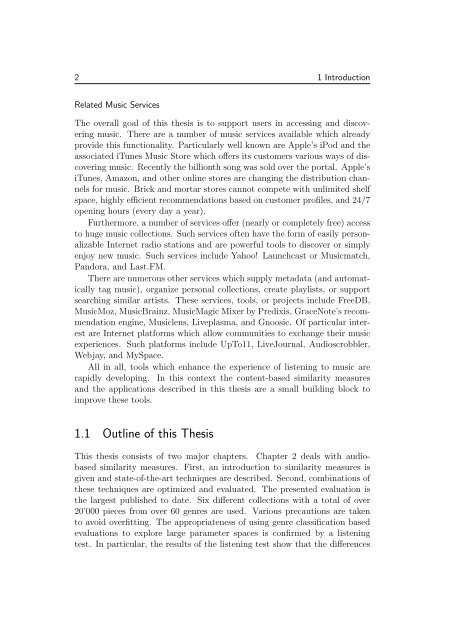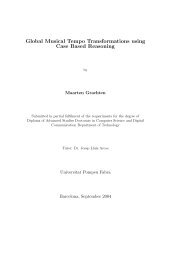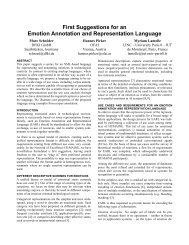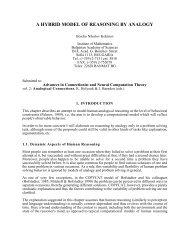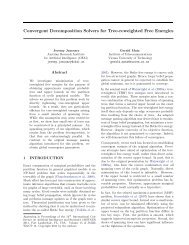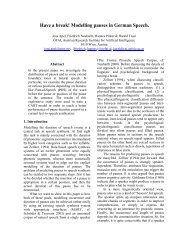Computational Models of Music Similarity and their ... - OFAI
Computational Models of Music Similarity and their ... - OFAI
Computational Models of Music Similarity and their ... - OFAI
You also want an ePaper? Increase the reach of your titles
YUMPU automatically turns print PDFs into web optimized ePapers that Google loves.
2 1 Introduction<br />
Related <strong>Music</strong> Services<br />
The overall goal <strong>of</strong> this thesis is to support users in accessing <strong>and</strong> discovering<br />
music. There are a number <strong>of</strong> music services available which already<br />
provide this functionality. Particularly well known are Apple’s iPod <strong>and</strong> the<br />
associated iTunes <strong>Music</strong> Store which <strong>of</strong>fers its customers various ways <strong>of</strong> discovering<br />
music. Recently the billionth song was sold over the portal. Apple’s<br />
iTunes, Amazon, <strong>and</strong> other online stores are changing the distribution channels<br />
for music. Brick <strong>and</strong> mortar stores cannot compete with unlimited shelf<br />
space, highly efficient recommendations based on customer pr<strong>of</strong>iles, <strong>and</strong> 24/7<br />
opening hours (every day a year).<br />
Furthermore, a number <strong>of</strong> services <strong>of</strong>fer (nearly or completely free) access<br />
to huge music collections. Such services <strong>of</strong>ten have the form <strong>of</strong> easily personalizable<br />
Internet radio stations <strong>and</strong> are powerful tools to discover or simply<br />
enjoy new music. Such services include Yahoo! Launchcast or <strong>Music</strong>match,<br />
P<strong>and</strong>ora, <strong>and</strong> Last.FM.<br />
There are numerous other services which supply metadata (<strong>and</strong> automatically<br />
tag music), organize personal collections, create playlists, or support<br />
searching similar artists. These services, tools, or projects include FreeDB,<br />
<strong>Music</strong>Moz, <strong>Music</strong>Brainz, <strong>Music</strong>Magic Mixer by Predixis, GraceNote’s recommendation<br />
engine, <strong>Music</strong>lens, Liveplasma, <strong>and</strong> Gnoosic. Of particular interest<br />
are Internet platforms which allow communities to exchange <strong>their</strong> music<br />
experiences. Such platforms include UpTo11, LiveJournal, Audioscrobbler,<br />
Webjay, <strong>and</strong> MySpace.<br />
All in all, tools which enhance the experience <strong>of</strong> listening to music are<br />
rapidly developing. In this context the content-based similarity measures<br />
<strong>and</strong> the applications described in this thesis are a small building block to<br />
improve these tools.<br />
1.1 Outline <strong>of</strong> this Thesis<br />
This thesis consists <strong>of</strong> two major chapters. Chapter 2 deals with audiobased<br />
similarity measures. First, an introduction to similarity measures is<br />
given <strong>and</strong> state-<strong>of</strong>-the-art techniques are described. Second, combinations <strong>of</strong><br />
these techniques are optimized <strong>and</strong> evaluated. The presented evaluation is<br />
the largest published to date. Six different collections with a total <strong>of</strong> over<br />
20’000 pieces from over 60 genres are used. Various precautions are taken<br />
to avoid overfitting. The appropriateness <strong>of</strong> using genre classification based<br />
evaluations to explore large parameter spaces is confirmed by a listening<br />
test. In particular, the results <strong>of</strong> the listening test show that the differences


